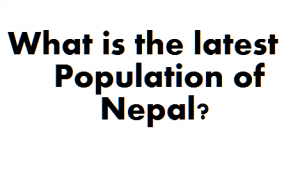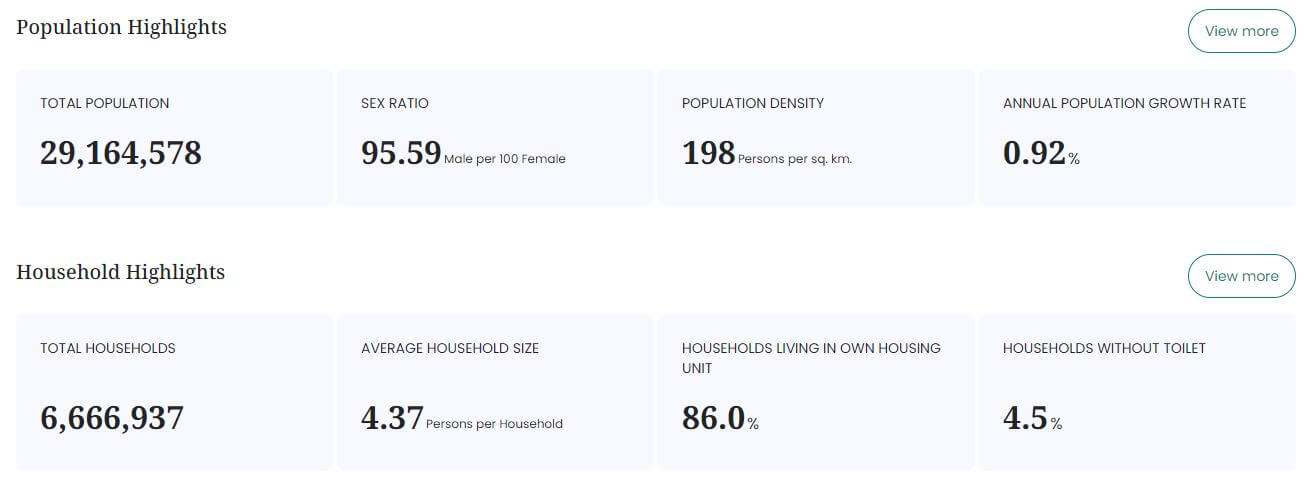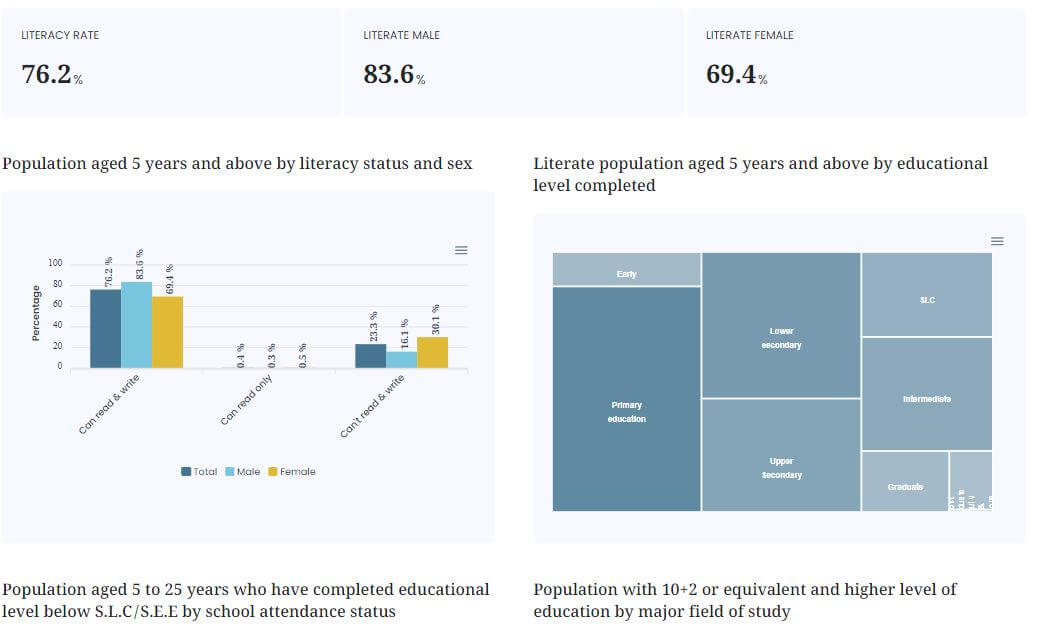Nepal Population refers to the total number of inhabitants in a particular geographical area of Nepal at a particular time. Counting the population is necessary for any country so that different plans and policies can be made with the population as the base. The counting of a population, in general, is the census. The population census is a systematic procedure of collecting information about the population. United Nations has recommended population census be taken at least decennially. In some countries, it is taken quinquennially also. The significance of population census has been recognized by every country. Population census provides data about the population. Requests for more data have come in Nepal as well, not only from governmental agencies but from various organizations, political parties, and the general public also. The data supplied is used for different purposes. These are used for making plans and policies for the development of the country. This article provides complete information on Nepal population along with the up to date information on the latest population of Nepal.
Table of Contents
On what basis Nepal population is calculated?
The population of Nepal is calculated by the population census method, which takes place every ten years. The history of Nepal’s population census dates back to 1911. After the year 1911, the practice of taking census has been continued roughly every ten years. Initially, a short census schedule was used for the population census. Information was collected on the name of the head of household, the age of a person, sex and occupation, the ability to work, the number of livestock, and means of transportation. But, the final results were presented only in aggregates i.e. head counts. The first scientific census in Nepal took place in 1952/54. That year, the Nepal census was conducted in two parts of the country, separated by two years.

Who conducts the census for Population in Nepal?
In Nepal, conducting the population census is the primary function of the population section under the social statistics division of Central Bureau of Statistics (CBS). CBS conducts the population census of Nepal decennially. For the 2011 census, working with 58 municipalities and 3915 village development committees at a district level, they recorded the data. Data included statistics on various attributes of the population. The Nepal Population census in Nepal is conducted by the de facto method. It is the method that counts all persons as residents of the place they happen to be at the time the census is taken. This method is very clear and simple and international comparison is easy as well.
Latest Total Population in Nepal data

The latest census of Nepal took place in 2021 AD. According to it, the total population of Nepal is 29,164,578. The Nepal population had increased by more than 3 million people from the past census of 2011 AD when the population was 26,494,504. Geographically, the country is divided into three east-west ecological belts: Northern Mountains, Middle Hills, and Southern Terai. Terai is the most populous among the three according to the 2011 census. The most populous development region was the central region. There were 5,427,302 households, and the average household size was 4.88. The annual population growth rate is 1.35%. Nepal is a small landlocked country located between 2 large neighboring countries, India and China. Both of these countries have a population of more than one billion people. Compared to these, Nepal’s population of 28 million (projected for 2015) is very small but the population growth in the country is a problem of major concern for a small country like ours. So, the necessary steps should be taken to control the population.
According to the twelveth census held recently, the total population of Nepal is 2 crore 91 lakhs. Census is generally taken in 10 years. Census that was taken recently has the increment of Nepal population by 10.18 percent. In 2058, the total population of nepal was 2 crore 37 lakhs.
These statics shows the actual population of Nepal. Yes, the population increment percentage is 10.18 now. To know more about the population of Nepal, you must be here.
Nepal ko Janganana 2068
Nepal ko Janganana 2068 census was two crores and sixty-six lakhs. Population of Nepal in 2013 is 27,797,457, 2012 is 27,474,377, 2011 is 27,156,367 and 2010 is 26,846,016. Census is done in Nepal every ten years duration. During the census, all the factors of the population in different categories like age, religion, gender, and employment are determined. The population increment rate of Nepal is given by 14.99 percent (roundly, we can say it is 15 percent).
Nepal Population 2068
The eleventh census of 2068 BS gave the data of the total population of Nepal as two crores and sixty-six lakhs. Census was done in month Asar of 2068 Bs. There were 2 crore 37 lakhs population according to the tenth census done in 2058 BS. In ten years period, the total population of Nepal was increased by 29 lakhs.
Census has a great role in the development of a country. Plan for development is made looking at a census. The different categories in census helps to make effective plans for development. Upcoming census of Nepal will be taken in 2078 BS, which will be the thirteenth census of Nepal.
In Nepal Census is conducted by Nepal Central Bureau of Statistics. Central Bureau of Statistics (CBS) was established in 1959 under Statistics Act, 2015 BS as the central agency for the collection, consolidation, processing, analysis, publication and dissemination of statistics. Census 2011 also known as the National Population and Housing Census 2011 marks a hundred years in the history of population census in Nepal. Nepal has been conducting population censuses almost decennially and the census 2011 is the eleventh. The first population census was conducted in 1911 A.D. (1968 B.S.). The census is considered as the first modern census of Nepal which was held or conducted on 1952/54. It has been introduced internationally as comparable concepts, definitions and classifications.
Nepal Population 2078
The Census 2078-2079 BS indicate that as of Mangsir 2079 BS, the country’s population is 29,164,578, where 14,911,027 are females and 14,253,551 are males. Population density is 198 person per sq km. The annual population growth rate is measured to be 0.92%.
The Population of Nepal as of the census day, i.e., held on June 22, 2011, stands at 29,164,578, showing the total population increases at the rate of 0.92% per annum. Likewise, the total number of households founds in the country is 6,666,937 with 86% owned, 2.8% rented, and 0.2% institutional.
Population density (average number of population per square kilometer) at the national level is 198 compared to 157 in 2001.

According to the National Population and Housing Census 2021 results, the literacy rate of Nepal is 76.2%, where 83.6% of males are literate and 69.4% of females are literate.

Nepal Census by Nepal Central Bureau
As Nepali culture is different within the country, there are 126 caste and ethnic groups reported in the census 2011. Among many caste the largest caste/ethnic groups are Chhetris as they have 16.6% (4,398,053) of the total population, as Brahman-Hill have (12.2% ; 3,226,903), Magar (7.1% ; 1,887,733), Tharu (6.6% ; 1,737,470), Tamang (5.8% ; 1,539,830), Newar (5%; 1,321,933), Kami (4.8%; 1,258,554), Musalman (4.4% ; 1,164,255), Yadav (4%; 1,054,458) and Rai (2.3%; 620,004). Ten types of religious categories are being reported in the census. Hindu is followed by 81.3 percent (21,551,492) of the population followed by Buddhism (9%; 2,396,099), Islam (4.4%; 1,162,370), Kirat (3.1%; 807,169), Christianity (1.4%; 375,699), Prakriti (0.5%; 121,982), Bon (13,006), Jainism (3,214), Bahai (1,283) and Sikhism (609).
Nepal Literacy Rate
According to the total literacy rate population those aged 5 years was 54.1 percent in 2001 and later it has been increased to 65.9 percent in 2011 and now it is 76.2% in 2021.
The Central Bureau of Statistics working with the 58 municipalities and the 3915 Village Development Committees at a district level recorded data from all the municipalities and villages of each district. The whole operation of the census took five years from 2008/09 (2065/66 B.S.) to 2012/13 (B.S.2069/70) to complete preparatory works, data collection, data processing, and tabulation.
Though a small country, we have a very high population density, especially in Urban areas. Hence proper control measures and awareness are necessary for the country to control its increasing population.
